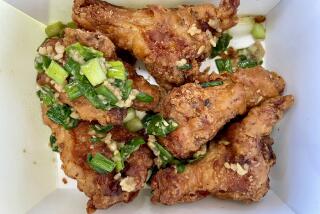Where Asian Pepper Pot Meets the Melting Pot
- Share via
PENANG, Malaysia — Malay cooking is noted and savored for its heady melange of spices, each adding a special if often faint flavor to the pot, all adding up to a most satisfying dish when it comes off the fire. The same may be said of this island’s people.
Chinese, Indian, Thai, Burmese, British and indeed Malays have taken turns stirring herbs and powders into the Penang chafing dish, the result being an eclectic yet nonetheless piquant mix of century-old temples, burning joss sticks, a milling harbor of every conceivable craft, hawkers’ food stalls as colorful, smoky and cacophonous as you are likely to find in the entire East.
Penang, in the Strait of Malacca and connected to the Malay Peninsula mainland by a bridge, was obtained from a sultan by a British sea captain two centuries ago. It was the East India Co.’s main trading post beyond India until the founding of Singapore in 1819, yet remained important to the empire for its spice trade.
Legend has it that the captain who started it all, Francis Light, was having trouble getting natives to clear heavy jungle undergrowth for developing the town. So he loaded his cannons with silver coins, fired them into the forest and the place took on a parade-ground smoothness overnight.
Penang still retains vestiges of its British raj past in Victorian buildings of considerable charm, the requisite clearings for soccer and cricket pitches. Yet, today the island is unmistakably Oriental, the country’s major resort with endless miles of white beaches, mist-shrouded mountains and jungle walkways just waiting to be explored by visitors.
Here to there: Malaysian Airlines gets you to Kuala Lumpur without plane changes, Singapore, JAL, Korean Air and Philippine Airlines with one. Take Malaysian for the 45-minute flight on to Penang, or drive 235 miles up the peninsula to Butterworth, then cross Asia’s longest bridge to Penang.
How long/how much? Two or three days for town, another for hitting those wonderful beaches. Lodging costs are moderate, dining downright cheap.
A few fast facts: Malaysia’s ringgit was recently valued at 250 to our dollar. Exchange in banks or at money changers, which often give a better rate. Weather is equatorial, warm and humid year-round. The capital is Georgetown but called Penang by everyone. Use trishaws to get around town, about 75 cents per kilometer, but agree on price before getting aboard. And put aside $1.50 airport tax for domestic flights, $8 international.
Getting settled in: Golden Sands Hotel (Batu Feringhi Beach; $68 to $80 double) is on Penang’s best stretch of beach, a thoroughly modern place with each room balcony having view of green hills or water. Acres of landscaped tropical greenery, beautiful free-form pool, all water sports. Rooms bright and attractive with rattan touches, three good restaurants, but there are others nearby along with hawkers’ stalls.
Palm Beach (Batu Feringhi; $48 to $60) shares the same glorious beach, a sprawling motel-type layout around central pool, more water sports and a guided jungle walk, rooms large and air-conditioned, simply but well-furnished. Restaurant serves Western food, also what is considered the most authentic Penang fare. Malaysia’s prime minister was enjoying the latter one evening we were there.
Holiday Inn (same beach; $55 to $70) has all of the above beachside recreation in addition to a disco for nocturnal types. Lots of business folks here, as Holiday Inns are conveniently located throughout Asia.
Regional food and drink: Laksa asam is a big specialty around here, thick rice noodles in a tangy soup flavored with lemon grass, ginger and tamarind, either chicken or shrimp added, then garnished with fruits or vegetables. It’s delicious. Another favorite for breakfast is Penang choke, rice porridge with lean pork, chicken and an egg stirred in and served with spring onions and crispy noodles.
Try kueh teoio, rice noodles stir-fried in oil with chili, cockles, prawn, ginger and soy, another specialty. And of course innumerable types of fresh seafood: crab, snapper, tiger prawns, lobster and grouper being particularly favored.
For dessert you’re sure to enjoy goreng pisang, banana dipped in batter and deep-fried until crisp and golden. Or ais kacang, cooked sweet red beans and cut fruit on a mound of shaved ice, sometimes topped with ice cream. Cold and refreshing on a hot day.
Moderate-cost dining: Eden Seafood Village (69A Batu Ferringhi) is a seafood-market-restaurant little less than an extravaganza. Enter past dozens of tanks holding fish and shellfish, then move into a brilliantly lighted tented room festooned with Chinese lanterns and candles. Music from a small band, floor-show acts between courses and some of the best Chinese seafood we’ve ever tasted. A fantastic eight-course spread for $10: lobster, braised shark fin with crabmeat, tiger prawns, steamed pomfret, Mandarin chili crabs and a few others tossed in.
Ha Shim Satay, Happy Garden and Coconut Garden are three good ones near the above hotels. Locals agree that the first has the island’s best satay, a dozen for $1.25. Happy Garden favored for seafood, Coconut for Chinese, more than you can down at either of these for $2.50 per person.
Penang’s three most popular locations for hawkers’ stalls are Gurney Drive, Gottlieb Road and the Esplanade. Sample all of Malaysia’s best dishes at any of these sites for a pittance.
On your own: Don’t miss the 46-mile tour around the island for breathtaking forest and shoreline scenery; mango, durian, rubber and coconut plantations, the last with trees so tall they’re unreal. Then take the steep funicular up Penang Hill for a glorious panorama of the town and surrounding countryside.
Penang is teeming with temples, including Kek Lok Si, said to be the largest and one of most lavish in Southeast Asia. Up a series of granite steps from there takes you to Ban Hood Pagoda, a 98-foot and very ornate tower combining Chinese, Thai and Burmese architecture.
Sooner or later someone is going to suggest a visit to the Snake Temple where live pit vipers curl around just about everything within, said to be doped by the heavy fog of temple incense. You may have your picture taken with one of these poisonous rascals for an outrageous sum, if scary reptiles are your thing. We passed on this once-in-a-lifetime opportunity.
For more information: Call the Malaysian Tourist Center at (415) 788-3344, or write (600 Montgomery St., San Francisco 94105) for a brochure on Penang with map, another on all of Malaysia.


